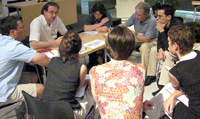The promotion of participatory procedures, as it is represented by the CIPAST platform, is a direct answer to the second priority of the European Commission’s Science and Society Action Plan (http://ec.europa.eu/research/science-society/action-plan/action-plan_en.html) which demands to bring science policies closer to citizens and especially requires actions aiming at involving civil society: "Science activities need to centre around the needs and aspirations of Europe's citizens to a greater extent than at present. Citizens must also be given the opportunity to express their views in the appropriate bodies".
The CIPAST experience has confirmed a very strong interest in public participation in science and technology. Training for public participation in science and technology has to be considered as a multiple objective aim: as training activity before (and for) the implementation of a public participation initiative but also as an offer to get informed about public participation in general – and not being directly targeted to the translation into training action.

For example, participation in research development is likely to be on a small scale, involving small numbers of participants with particular ‘life experience’ and vested interests (such as patients organisations etc), whereas participation aimed at wider social diffusion and assessment is likely to involve larger numbers of ‘members of the public’ in an open setting (such as provided by public museums). Likewise, intra-institutional participation may be based on focus-group and similar methodologies, whereas participation in open, public forums may be based on interactive, deliberative methodologies supported by various communication tools, such as video-conferencing and the Internet.
Accordingly the training tools have to be available for a variety of “users” who will mobilise them in diverse situations. CIPAST therefore has decided to put case studies at the core of the training and to focus on a process of active and participative learning.

The case study model was first tested in a workshop in Dresden 2006 and then revised for a second workshop 2007 in Procida (Naples), Italy, taking into account that it is necessary to involve the participants in active problem solving activities. Learners were put in the role of practitioners and were enabled to bring their experiences together in a learning situation.
In small groups participants had to perform tasks that illustrated some of the difficulties of design and implementation of public participation in practice such as the choice of a procedure, convincing a given policy maker of the rationale for public participation or drafting a press release.
Lessons learned

The aim of exchange of experience can certainly be met by means of the case studies. Various aspects of public participation can be debated during the sessions, from budget to impact, and from the selection of participants to the subtlety of a certain methodology. The feedback of the observers pointed out the fact that CIPAST training package should in the end propose two types of case studies aiming at either:
- designing a participatory process in a specific context: frame the issue, identify the actors, choose a methodology and implement the process ( ‘GM Vine’ , ‘Nano Dialogue’ , ‘Nuclear Waste’ , ‘Doing Dialogue’ ),
- or learning more in depth about one specific methodology ( ‘Ocean Rise’ ).
Although every project is unique the presented case studies clearly show the feasibility of public participation in the broad range of science and technology issues. And the CIPAST workshops proofed that these case study experiences can be transferred and shared. The fact that one cannot apply standardised rules on how to apply a methodology didn’t turn out as a disadvantage for the training situation.
The CIPAST platform
Besides the training package and to structure a broad network of European actors involved in participative procedures , CIPAST has also set up a database (See chapter ‘What else?’/ ‘Experts’ and also http://www.cipast.org/cipast.php?section=13.) which identifies key persons or institutions that may concretely contribute to promote the development of participatory procedures in science and technology in their country. It also gives an overview of several past or ongoing participatory processes. The transfer of knowledge and expertise finally is accompanied by tools like newsletters, website and a discussion list (http://www.cipast.org/cipast.php?section=52).
If you want to learn more about the CIPAST platform and its activities, please visit the website www.cipast.org.


